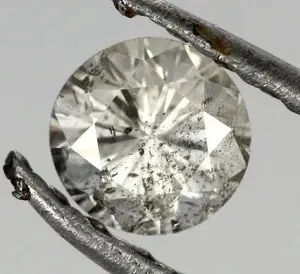
Salt and Pepper Diamonds? No thanks…
Beware of companies selling inferior diamonds using a big marketing budget
Salt and pepper diamonds…dark and stormy diamonds…diamonds with “unique characteristics” …since the lockdown began, I have read on social media pretty much every possible way some companies are trying to sell inferior quality diamonds using floury, romantic terms that paint these imperfections in a positive light.
So ...what do these terms mean?
In short, they are simply clever marketing terms to help tell a story that will ultimately encourage a customer to pay over the odds for an inferior diamond.
All of the terms mentioned at the start of the article are marketing agency phrases to sell diamonds with a lot of inclusions, diamonds that would have always been considered less desirable, that have less fire and brilliance and therefore less sparkle, diamonds that most reputable Irish jewellers would not stock.
These diamonds are attained cheaply, marketed heavily, packaged beautifully and sold for enormous prices over market value.
A blogger might convince you otherwise, they may convince you that black marks are inimitable footprints that make your diamond unique to you…well ask yourself if you spent a lot of money on a Porsche would you like a big dent in the bonnet because it would be one of a kind? Me either!
What are inclusions?
Inclusions are formed under incredible heat and pressure; they are naturally occurring imperfections within a diamond which can take several forms. You will get inclusions in almost all diamonds in the commercial market however the GIA scale should be referred to when choosing a diamonds clarity.
Clarity can be compromised on to an extent because generally speaking if you stay between VVS1 and Si2 you will still have a beautiful dancing diamond.
We do not stock diamonds past Si2 clarity in our store and would not recommend buying one past Si2. (So this would discount I1,I2,I3 diamonds)

So how do inclusions affect diamonds?
All diamonds are beautiful, they’re incredible, naturally occurring minerals and regardless of their colour or the inclusions within them, when you look at a diamond crystal it really is remarkable that it has come out of the ground! While they are amazing and unique that doesn’t mean that all diamonds are suitable for jewellery.
The more inclusions in a diamond, the more “dead” the stone. More inclusions mean that the facets cut into the diamond to spread light and create the “sparkle” are less useful as black or white marks from tiny crystals get in the way of the light as it tries to reflect around the diamond.
A heavily included diamond will have no life in it.

But I love black marks in diamonds, I think they give a stone character?
No problem that’s your prerogative, however be warned that a diamond with a lot of inclusions will have its integrity compromised and is weakened by these inclusions. As strong as a Diamond is, if you bang one with many inclusions it is liable to smash into pieces!
You have said not to buy a diamond past Si2 on the GIA scale but I am looking at an Si3 diamond?
Go to a different shop! Si3 does not exist. The Si3 grade is commonly used by discount chains, there is no such thing on the GIA scale, the next lowest clarity grade after Si2 is I1 sometimes referred to as P1. Avoid.
At the end of the day, beauty is in the eye of the beholder and what you find attractive in a Diamond may differ to what I do but it is important that you are in possession of all the information and not pushed towards a particular diamond because
Shop from our range of Beautiful Diamond Jewellery Today.
Example of a beautiful 1ct D Colour Si1 Clarity Diamond.
Richard Wehrly



